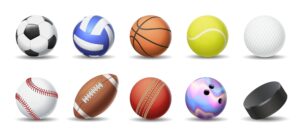Introduction
Sports balls play a very significant role in almost all sports. Football is round, while basketball is perfectly engineered. Over the years, sports balls have changed in shape, material, and manufacture. From leather to rubber to synthetic materials, sports balls come in different shapes, different sizes, different structures, making each one uniquely suited for the sport it defines. The right ball in the right game makes a difference in performance, safety, and enjoyment.
The post covers and educates about the history, evolution, types, and materials of sports balls, as well as different sports’ ways and influences when it comes to game playing. The article will highlight some of the most popularly used sports balls worldwide. Read to the end, and you will have a complete difference in the way you have seen and appreciated these rather simple objects that are part of sports culture all over the globe.
The History and Evolution of Sports Balls
The Origins of Sports Balls
For centuries sports have existed, and with them, the balls. The first ball used in a sport has been recorded among ancient civilizations-the Egyptians as well as the Greeks and the Mesoamericans. These balls, in the early days, were made mainly from natural materials-animal bladders or skins, or even woven plant fibers.
- Ancient games and balls: The Mesoamericans race like the Aztecs and the Mayans, who played with balls made of rubber in their games called the Mesoamerican ballgame. Balls were known to Greeks as leather ones, stuffed with feathers or hair for their game of Episkyros, which was played similar to the modern games of football and rugby.
- The Medieval Era: In Europe, medieval games mostly relied on inflated leather balls for example mob football- an ancestor of modern football. Sizes and shapes varied significantly in these medieval games.
The Industrial Revolution and the Birth of Modern Sports Balls
Industrial revolution in the nineteenth century resulted in mass production of sports merchandise. This would systematize the design of sports balls and ultimately formalize most modern sports.
The Evolution of Football: The Early forms of football involved the use of animal bladders, typically pigs, encased in leather. However, by the mid-19th century, rubber bladders began to take the place of the former version, thus giving a more durable and standardized ball.
The New Age of Synthetic Materials: With the synthetic rubber development and plastics in the 20th century, balls became lighter, more durable, and more versatile than any ball had previously been, and now it is possible to find a ball for every sport.
Types of Sports Balls
Behold different sizes, shapes and materials, sports balls vary according to the sport they are made for; here are the most popular kinds of sports balls:
Football (Soccer Ball)
- Evolution: The ball has changed from being a simple stitched leather ball to a highly engineered object. The primitive soccer balls were made of leather and usually spherical but became misshapen after being used for kicking around in the rain.
- Design: Modern footballs are made synthetically, most commonly with synthetic leather or a mixture of polyurethane and air, followed by latex or rubber bladders.
- Material: Continuing on the outer covering, the PU (polyurethane) and PVC (polyvinyl chloride) play a role in these materials to serve durability along with water resisting capability.
Basketball
- History: Basketball was invented by Dr. James Naismith in 1891, and basketballs were made of rubber in the early ea more evolution to include a textured leather surface.
- Design: Basketballs are mostly spherical in form and massive as compared to soccer balls. The surface of the ball has deep channels as well as textured panels so that players can have a better grip on the ball.
- Materials: Traditionally, these basketballs were made of leather but now most modern sets are neither of the two traditional materials: rubber or composite materials; these can enrich their lifetime both indoor and outdoor.
American Football
- History: The prototypical American football originated in the middle of the 1800s and took shape more after that of a rugby ball.
- Design: Footballs of America are typically oval-shaped, which is called the “prolate spheroid,” that allows one to throw them with a spiral for more accuracy and distance.
- Materials: Its outer surface is usually leather; at the same time, its interior features a hollow rubber bladder for retaining air.
Tennis Ball
- History: In the earliest history of tennis, balls were made of cloth and stuffed with feathers. While tennis evolved, the types of balls changed to rubber, which is covered by felt.
- Design: A tennis ball features a fuzzy exterior made from felt insides, which grips the strings of the racket and reduces bounce velocity.
- Materials: So, today’s tennis balls are made of rubber with a felt cover which generally contains wool and nylon, the most typical components.
Baseball
- History: This ball traces its lineage from the almost very beginning period of the nineteenth century. The formation of the very first baseballs had actually been of rubber and at present, the modernized baseball came into standardization with a cork interior and leather.
- Design: Baseball is a small, round and hard ball usually of about 22.5 cm circumference, having red stitches giving players a convenient grip to throw and catch better with precision.
- Materials: This ball has a core made of cork or rubber, and is wrapped in yarn inside a shell of leather.
Volleyball
- History: Volleyball, an outdoor game that originated in 1895, had leather balls at the beginning of its creation. Modern volleyballs consist of synthetic materials.
- Design: The volleyball is a round sphere, so it has to be light and can possibly make it easy to hit with the hand or arm.
- Materials: Synthetic leather or polyurethane directly outside surfaces of a ball, which leads to the high durability of the ball while it cannot absorb the air easily.
Innovations in Sports Ball Technology
The Journey Entered New Phases From the Advanced Technology in Material Science All These Years and Sports Balls Became Advanced too. Here are the several advances made in the design of sports balls:
Inflation Systems
There is some puff inflation advance system which helps the balls keep the pressure in perfect condition, so the balls have satisfied output during use. For example, many basketballs and footballs have different air valves that help maintain the proper inflation level.
Thermal Bonding and Seamless Design
Thermal-bonded soccer balls make buildings up with seams to make them last longer and not absorb water. This technology helps the balls perform the same in all climates.
Smart Balls
The last couple of years have really witnessed the entry of “smart balls” into the sports world. Instead of attaching sensors to equipment, sensors have been placed inside the balls themselves. These sensors provide data-on velocity, spin, trajectory, and other performance parameters. This technology is essential in analysis and training, particularly in the professional sports field.
Conclusion
Sports balls are not as easy as they appear, but are products of centuries of craft and innovative thinking. Their design, material composition, and technological advances do or do not shape the game and enjoyment today. Shall we just dribble up that basketball on a hot day



0 Comments